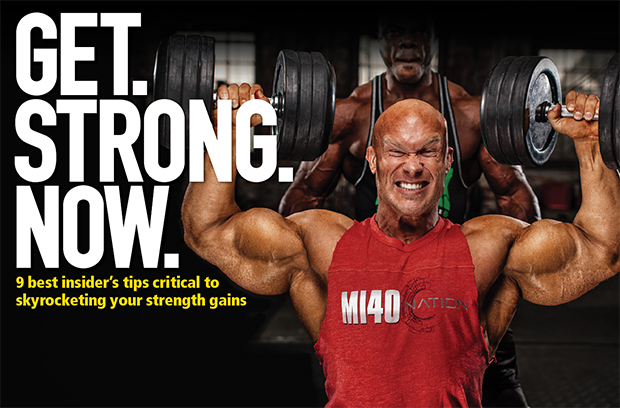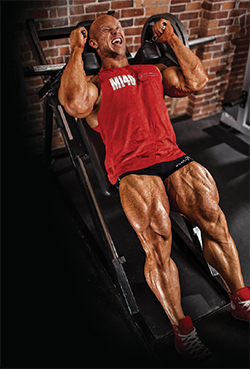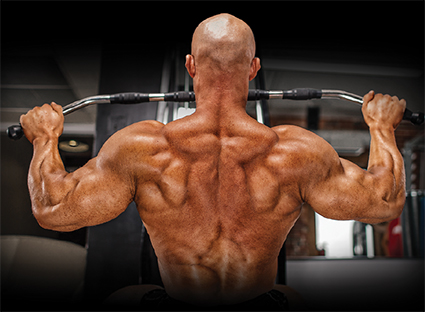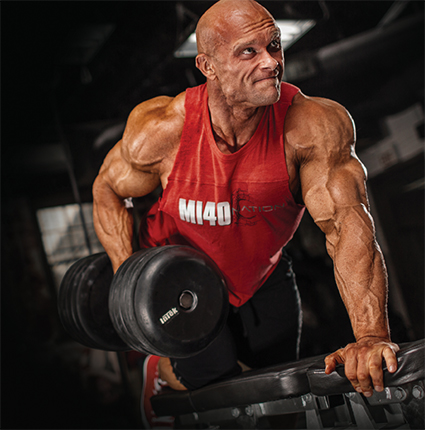9 Best Tips For Getting Strong

Show me an individual who walks onto the gym floor and doesn’t want to get stronger and transform their body. Sure, it not be your primary training goal, but in almost any kind of athletic endeavour, the stronger you are, the more successful you’ll be. And even those who train for maximizing muscle size, such as bodybuilders, surely know that a strong muscle is a big one.
What’s clear is that to be successful, it’s important to follow a planned, progressive approach in the gym rather than a haphazard, random system. One of the biggest roadblocks that can impede your strength gains is lack of knowledge, so I’m here to fill in some of the blanks that can stall your progress. As a trainer who holds numerous strength records and coaches many of the strongest people in the world, I’m going to provide you with the insight that can fast track your gains. Let’s go.
1. Start Here. Always.

Undertaking the task of lifting very heavy weights is serious business, but don’t load up the bar with heavy weights just yet. Every big lift you see, each one, starts with a thorough warm-up. Novices to strength might overlook this critical part of the workout, but it ultimately has a monumental impact on your ability to generate maximum force.
A proper warm-up has many documented benefits, but two stand out for our purposes: more efficient movement patterns and increased mental readiness. You won’t find a single successful lifter today who skips this important step, so don’t think you’ll be the first.
Toss aside whatever notion you might think a good warm-up should include. To get as strong as possible, you must include warm-ups with submaximal weights on the lift you’re performing. If you’re benching, warm up by benching. The same reasoning goes for deadlifts and squats or any other lift. By warming up in a specific manner, you’ll be both mentally and physically ready to achieve your absolute best.
There’s a less obvious benefit of warming up and that is to add volume. Volume is a formula defined as weight × sets × reps, so doing progressively heavier warm-up sets (none close to failure!) provides a significant amount of extra training volume without adding time to your workouts.
2. Prioritize What Comes First in Your Session.
You’ll hear me say this over and over: Strength is a skill. You’ll most effectively display this skill when you’re fresh, so that’s why you place the most difficult, heavy exercises early in your routine. It goes without saying that these exercises are always multi-joint in nature, such as rows, presses, squats, or pulls. These movements build the most strength, require the heaviest weights lifted, and demand the highest levels of coordination. No question, you’ll get the most benefit and achieve your best performances by prioritizing the most important core movement and doing it first in your routine.
3. Align Your Sets in Reverse.

The best way to get strong is to follow what’s called a reverse-pyramid system of training. That requires you do your heaviest sets first (after warm-ups) when your energy levels are highest at the beginning of your workout. Instead of pyramiding up to your heaviest set(s) of a movement, warm up and then go right to your heaviest loads. Each working set after that should be just a little lighter.
An important benefit of going right to your heaviest set and then backing off on the weight is a phenomenon called post-activation potentiation (PAP). It refers to the enhancement of muscle function following a high-force activity such as a very heavy set. Think of the baseball hitter in the on-deck circle who adds a weighted doughnut to his practice swings; when the weight is removed, he’s able to take a more explosive swing. That’s because the nervous system is expecting a heavier load, but instead it’s subjected to a lighter one. It works just like that in the gym too. When you back off in weight, the weight feels lighter and you move it much faster!
4. Build More First Reps into Your Training.
You don’t train for the 100-metre dash by logging countless miles on the track oval. The same logic applies to strength as well.
Let’s start by defining your strength limit, which is measured as your one-repetition maximum (1RM)—the most weight you can do for a single rep on a given exercise while maintaining form. In your training, then, you want to be doing more firstreps. That is, instead of thinking 3 sets of 10 reps, flip it and instead do 10 sets of 3. This is exactly the same amount of volume, but you get over 3 times as many firstrepetitions (10 versus 3). Those are the ones you’re strongest on!
Arranging your training this way means more first reps and more practice to build and perform the skill of strength.
5. Practice, Practice, Practice.
How do you get good at a skill? You rehearse it over and over and over, just as you would do for any challenging endeavour.
Pavel Tsatsouline, in his book Power to the People,described how a neurological groove needs to fire in a certain sequence and intensity. Essentially, he was saying you need to practice the same movement repeatedly with correct technique to build the skill of strength. And then do some more.
I’ve heard some folks say that it takes 10,000 correctly performed reps to master a movement. Every repetition you perform in training, from your initial warm-up to your heaviest sets, allows you the opportunity to perform a rep correctly. Every rep you do, then, becomes a prime opportunity to literally get better!
6. Start Getting Explosive in Your Training.

Generate more explosion in your lift and you’ll build strength. Neither the targeted muscles nor your central nervous system “know” the actual amount of weight on the bar you’re lifting, but they do understand muscle tension and force produced.
It requires some knowledge of basic physics. Consider that force equals mass multiplied by acceleration. For example, by moving the bar quickly using a lighter weight you can equal or surpass the force put into moving a heavy weight that’s not moving quickly. When you do your lighter sets with maximal acceleration through the entire range of motion, it’s called compensatory acceleration training (CAT). Greater amounts of force exerted into the bar create higher amounts of muscle tension. Importantly, this not only builds strength but also helps with muscle hypertrophy because you recruit a higher amount of fast-twitch muscle fibres (the ones with the most potential for growth).
After you’ve warmed up, when training your core multi-joint exercises and regardless of whether the weight is heavy or light, be intent on moving the bar as fast as possible. (Just be extra careful with heavy weights because bad form here can result in injury.) You’ll produce higher amounts of force, so the weight will feel lighter, and “the intent” will produce limit and explosive strength adaptations.
7. Begin Each Rep from a Dead Stop.
Ever notice that the first rep on an exercise such as flat-bench dumbbell presses, where the start position is with the weights just outside your shoulders, is often one of the toughest? That’s because on that first rep only, you begin the move from the bottom position, which doesn’t allow elastic energy to build up during the eccentric (negative) phase. This energy is real, and it actually helps you propel through the initial stages of the positive rep. Ordinarily, when you lower a bar under control and smoothly reverse direction going into the positive rep, you’ll benefit from the elastic energy, which makes the lift easier.
But there are times when you want to make a movement harder, which allows you to focus on building strength at the bottom of the range of motion, and you do that by eliminating the elastic energy. That’s exactly how the deadlift from the floor works, in fact. You can easily do this on other movements by stoppinga motion at the very bottom for about two seconds, keeping your body tight, and then exploding up. You’ve just made that same movement harder; the muscles now have to do all the work and there’s no assistance from built-up energy. You can easily do this type of training in the power rack too; just set the safeties at the lowermost point in your range of motion and allow the bar to settle on each rep. This type of training should be done in addition to your regular foundation movements.
8. Stop Trying to Achieve Everything at Once.
Your training efforts should always be purpose driven. That is, if your goal is to bench press 405 pounds, you will not concurrently be able to set a goal of running a six-minute mile. In fact, if you’re trying to achieve both simultaneously, you’ll very likely fail at each. Decide your priorities and then plan your training accordingly. For some, creating a plan of attack may be tough to do, so procuring a qualified coach can help. If your commitment is to become strong, make strength your top training objective. That means heavy weights and lower reps, while doing only minimal amounts of cardio.
All too often, you see inexperienced trainers seeking to get strong, lean, explosive, and as muscular as possible, all at the same time. That’s not how it works. You can cycle training objectives rather than trying to achieve them all concurrently, and you’ll ultimately be much more successful.
9. Visualize a Perfect Lift.

Before you ever begin a movement, your brain must think about what needs to be done. Nothing earth-shattering there, but consider that among the world’s strongest men, correct movement patterns are visualized beforethey’re ever performed. In fact, that practice began with former Eastern Bloc sports scientists almost 75 years ago, and it made Soviet athletes among the world’s best.
My recommendation is to take 10 to 15 minutes each day and visualize yourself lifting with perfect form. Find a dark, quiet spot and just relax. See yourself as clearly as possible in sight, sound and feeling. Visualize yourself doing your strength exercises with optimal technique in a dominating fashion.
One interesting experiment conducted by Dr. Judd Biasiotto at the University of Chicago included participants divided into three groups to test their free-throw accuracy. After establishing a baseline, Biasiottohad the first group practice free throws every day for an hour; the second only visualized themselves making free throws but didn’t actually practice, and the third group did nothing. All three groups were retested after 30 days. The first group improved by 24 percent, but surprisingly, the second group improved by 23 percent—without ever shooting a free throw. The third group, as would be expected, didn’t improve at all.
The point is this: See yourself doing it right and you’ll do right!
Successful strength athletes have many traits in common, and these are among the most important ones. There’s no better way to make gains than incorporating many of these important tips into your training.

